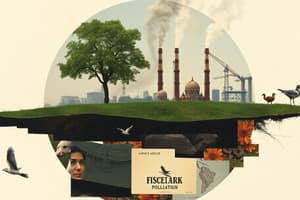Podcast
Questions and Answers
What are the four main types of pollution mentioned in the text?
What are the four main types of pollution mentioned in the text?
- Land, light, thermal, and visual pollution
- Air, water, soil, and noise pollution (correct)
- Plastic, paper, metal, and glass pollution
- Radioactive, thermal, light, and visual pollution
What is a significant cause of air pollution according to the text?
What is a significant cause of air pollution according to the text?
- Burning of fossil fuels in transportation, energy production, and industrial processes (correct)
- Overconsumption of fruits and vegetables
- High levels of noise pollution
- Excessive use of plastic materials
Which greenhouse gases are highlighted as primary drivers of climate change?
Which greenhouse gases are highlighted as primary drivers of climate change?
- Oxygen, helium, and nitrogen
- Argon, krypton, and xenon
- Hydrogen, neon, and radon
- Carbon dioxide, methane, and nitrous oxide (correct)
Which agreement aims to limit global warming to well below 2°C above pre-industrial levels?
Which agreement aims to limit global warming to well below 2°C above pre-industrial levels?
What is a common source of water pollution mentioned in the text?
What is a common source of water pollution mentioned in the text?
How are biodiversity conservation, pollution reduction, and combating climate change related?
How are biodiversity conservation, pollution reduction, and combating climate change related?
What does biodiversity refer to?
What does biodiversity refer to?
Which human activities have contributed to the decline of biodiversity?
Which human activities have contributed to the decline of biodiversity?
What are some essential ecosystem services provided by biodiversity?
What are some essential ecosystem services provided by biodiversity?
What is pollution?
What is pollution?
How do initiatives like the Ramsar Convention contribute to environmental protection?
How do initiatives like the Ramsar Convention contribute to environmental protection?
What can human activities like habitat loss lead to?
What can human activities like habitat loss lead to?
Flashcards are hidden until you start studying
Study Notes
Exploring the Environment: Biodiversity, Pollution, and Climate Change
The term 'environment' encompasses not just the physical world around us but also the intricate balance of life within it. To understand the environment better, let's dive into three fundamental aspects: biodiversity, pollution, and climate change.
Biodiversity
Biodiversity refers to the variety of life on Earth, including all living organisms: plants, animals, fungi, and microorganisms, as well as their interactions and relationships within ecosystems. Each species plays a unique role, contributing to the overall health and resilience of its environment. The importance of biodiversity is twofold: it provides essential ecosystem services, such as pollination, water filtration, and nutrient cycling, and it also contributes to human well-being, in terms of food security, medicine, and recreational opportunities.
Unfortunately, human activities such as habitat loss, overexploitation, and invasive species have contributed to the decline of biodiversity. However, efforts to conserve and restore habitats are helping to protect our natural heritage. For example, initiatives like the Ramsar Convention and the United Nations Sustainable Development Goals (SDGs) aim to reduce the loss of biodiversity and promote sustainable use of natural resources.
Pollution
Pollution is the introduction of substances into the environment that harm living organisms, their habitats, or ecosystems. There are four main types of pollution: air, water, soil, and noise pollution. Air pollution, for instance, is caused by the release of gases, particulate matter, and chemical compounds into the atmosphere, often resulting from the burning of fossil fuels in transportation, energy production, and industrial processes.
Water pollution, on the other hand, occurs when pollutants enter water bodies such as rivers, lakes, and oceans. Common sources of water pollution include agricultural runoff, oil spills, and industrial waste. Soil pollution, although less frequently discussed, refers to the contamination of soil by hazardous substances like heavy metals, pesticides, and waste. Noise pollution, often overlooked, results from the excessive production of sound, which can harm wildlife and lead to human health issues.
Despite the negative impacts of pollution, there are solutions being implemented, such as the reduction of greenhouse gas emissions, adoption of cleaner energy sources, and improved waste management systems. International agreements like the Montreal Protocol, the Paris Agreement, and the Basel Convention help to address various pollution issues and promote sustainable development.
Climate Change
Climate change refers to the long-term alterations in global weather patterns and climate systems, driven by human activities. Greenhouse gases such as carbon dioxide, methane, and nitrous oxide trap heat in the atmosphere, leading to rising air and ocean temperatures, sea level rise, and more frequent extreme weather events.
The widespread adoption of fossil fuels and deforestation are two primary drivers of climate change. As a result, global temperatures are rising, glaciers and ice sheets are melting, and the ocean is becoming more acidic, with devastating consequences for ecosystems and human societies.
To address the challenges of climate change, international efforts, such as the Paris Agreement, aim to limit global warming to well below 2°C above pre-industrial levels and to pursue efforts to limit the temperature increase to 1.5°C. Promoting renewable energy, energy efficiency, and sustainable land use practices are essential steps in mitigating the effects of climate change.
Conclusion
Our environment is a complex and interconnected web of life, and understanding its various components is crucial for preserving the planet for future generations. By promoting biodiversity conservation, reducing pollution, and combating climate change, we can ensure a sustainable future for generations to come. International agreements and local initiatives are working to address these critical issues, and it is up to us to contribute to this important goal.
Studying That Suits You
Use AI to generate personalized quizzes and flashcards to suit your learning preferences.




